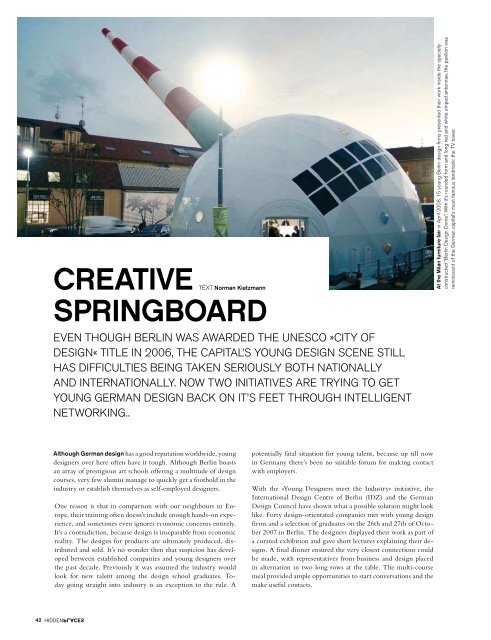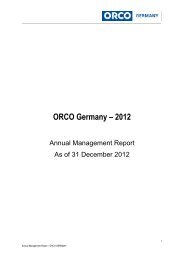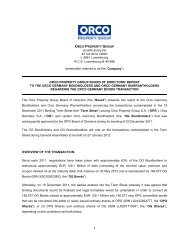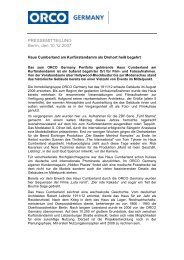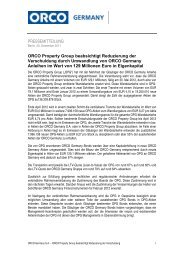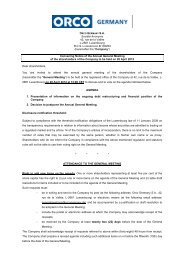PDF; 6,67 MB - ORCO Germany
PDF; 6,67 MB - ORCO Germany
PDF; 6,67 MB - ORCO Germany
Sie wollen auch ein ePaper? Erhöhen Sie die Reichweite Ihrer Titel.
YUMPU macht aus Druck-PDFs automatisch weboptimierte ePaper, die Google liebt.
CReative<br />
spRingboaRd<br />
TexT Norman Kietzmann<br />
eVeN THOuGH BerLiN WAS AWArDeD THe uNeSCO »CiTY OF<br />
DeSiGN« TiTLe iN 2006, THe CAPiTAL’S YOuNG DeSiGN SCeNe STiLL<br />
HAS DiFFiCuLTieS BeiNG TAKeN SeriOuSLY BOTH NATiONALLY<br />
AND iNTerNATiONALLY. NOW TWO iNiTiATiVeS Are TrYiNG TO GeT<br />
YOuNG GerMAN DeSiGN BACK ON iT’S FeeT THrOuGH iNTeLLiGeNT<br />
NeTWOrKiNG..<br />
Although German design has a good reputation worldwide, young<br />
designers over here often have it tough. Although Berlin boasts<br />
an array of prestigious art schools offering a multitude of design<br />
courses, very few alumni manage to quickly get a foothold in the<br />
industry or establish themselves as self-employed designers.<br />
One reason is that in comparison with our neighbours in europe,<br />
their training often doesn’t include enough hands-on experience,<br />
and sometimes even ignores economic concerns entirely.<br />
It’s a contradiction, because design is inseparable from economic<br />
reality. The designs for products are ultimately produced, distributed<br />
and sold. It’s no wonder then that suspicion has developed<br />
between established companies and young designers over<br />
the past decade. Previously it was assumed the industry would<br />
look for new talent among the design school graduates. Today<br />
going straight into industry is an exception to the rule. A<br />
potentially fatal situation for young talent, because up till now<br />
in <strong>Germany</strong> there’s been no suitable forum for making contact<br />
with employers.<br />
With the »Young Designers meet the Industry« initiative, the<br />
International Design Centre of Berlin (IDZ) and the German<br />
Design Council have shown what a possible solution might look<br />
like. Forty design-orientated companies met with young design<br />
firms and a selection of graduates on the 26th and 27th of October<br />
2007 in Berlin. The designers displayed their work as part of<br />
a curated exhibition and gave short lectures explaining their designs.<br />
A final dinner ensured the very closest connections could<br />
be made, with representatives from business and design placed<br />
in alternation in two long rows at the table. The multi-course<br />
meal provided ample opportunities to start conversations and the<br />
make useful contacts.<br />
At the Milan furniture fair in April 2008, 15 young Berlin design firms presented their work inside the specially<br />
constructed “Berlin Design Dome”. With it’s rounded form and long red and white striped antennae, the pavilion was<br />
reminiscent of the German capital’s most famous landmark: the TV tower.<br />
The design platform »Create Berlin« is responsible for another<br />
initiative. They organised the »made in Berlin« exhibition that<br />
appeared as part of this year’s furniture fair in milan in from<br />
April 16 to 21, 2008. A total of 15 Berlin design firms displayed<br />
their work inside a dome-shaped pavilion with red and white<br />
striped antennae like Berlin’s TV tower. The exhibition was<br />
curated by Berlin designer Werner Aisslinger and design theorist<br />
Francois Burkhardt and included work from firms such as<br />
ett la benn, mark Braun, martin Holzapfel, Ilotllov and others.<br />
In comparison to their British, French, Japanese or Dutch<br />
colleagues, young German designers have hardly had a presence<br />
until now in milan. This time design from Berlin was celebrated<br />
in impressive style.<br />
This is even more significant considering the centre of the design<br />
world is not Cologne, Frankfurt or Berlin, but rather milan,<br />
where much more goes on than just the discovery and presentation<br />
of new trends. even more important are the industry scouts<br />
there who look for new talent and can make future design careers<br />
happen. The »made in Berlin« exhibition closed the circle and<br />
gave young Berlin designers a platform to get beyond the borders<br />
of both the city and the country.<br />
The »made in Berlin« exhibition concept could shape the entire<br />
direction of German design promotion, particularly as it provides<br />
an ideal extension to the »Young Designers meet the Industry«<br />
networking platform. As important as contacts with representatives<br />
from German industry is, design itself knows no national<br />
boundaries and shouldn’t just remain a kind of local colour. It<br />
would make excellent sense if the two young talent initiatives<br />
worked together in the future more closely and perhaps were<br />
even represented by a joint project in milan next year.<br />
The design initiative VIA (Valorisation de l’Innovation dans<br />
l’Ameublement) could be a useful role model for <strong>Germany</strong>. It<br />
was established by former French President Francois mitterand<br />
For the shade of their new »Matt« lamp,<br />
Berlin design label LLOTLLOV turned to a<br />
very unusual material: knitted wool.<br />
An energy-saving light bulb was used to<br />
avoid the wool heating up and catching fire.<br />
View of the »Berlin Design Dome«<br />
exhibition room in the Milan Zona Tortona.<br />
42 43


